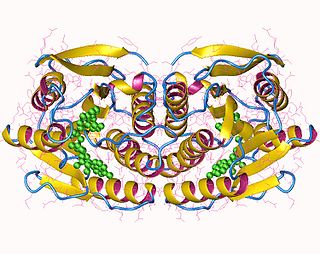In biochemistry, an oxidoreductase is an enzyme that catalyzes the transfer of electrons from one molecule, the reductant, also called the electron donor, to another, the oxidant, also called the electron acceptor. This group of enzymes usually utilizes NADP+ or NAD+ as cofactors. Transmembrane oxidoreductases create electron transport chains in bacteria, chloroplasts and mitochondria, including respiratory complexes I, II and III. Some others can associate with biological membranes as peripheral membrane proteins or be anchored to the membranes through a single transmembrane helix.
Microbial metabolism is the means by which a microbe obtains the energy and nutrients it needs to live and reproduce. Microbes use many different types of metabolic strategies and species can often be differentiated from each other based on metabolic characteristics. The specific metabolic properties of a microbe are the major factors in determining that microbe's ecological niche, and often allow for that microbe to be useful in industrial processes or responsible for biogeochemical cycles.
Nitrate reductase (NADH) (EC 1.7.1.1, assimilatory nitrate reductase, NADH-nitrate reductase, NADH-dependent nitrate reductase, assimilatory NADH: nitrate reductase, nitrate reductase (NADH2), NADH2:nitrate oxidoreductase) is an enzyme with systematic name nitrite:NAD+ oxidoreductase. This enzyme catalyzes the following chemical reaction
NADH:ubiquinone reductase (Na+-transporting) (EC 1.6.5.8 is an enzyme with systematic name NADH:ubiquinone oxidoreductase (Na+-translocating). In bacteria, three different types of respiratory NADH:quinone oxidoreductases (NQr) have been described: the electrogenic complex I, also called NDH I in bacteria, the non-electrogenic NADH:quinone oxidoreductases (NDH II), and the Na+-translocating NADH:quinone oxidoreductases Na+-NQr. The common function of these transmembrane enzymes in respiration is to oxidize NADH using ubiquinone (Q) as electron acceptor. The net reaction thus yields ubiquinol (QH2), the reducing substrate of enzyme complexes further along the respiratory chain, and NAD+, which is used as oxidizing agent in numerous cellular processes.



